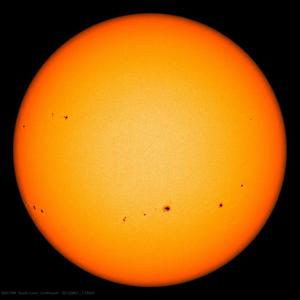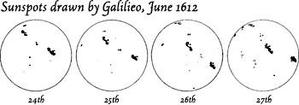Glossary term: Tache solaire
Description: Une tache solaire est une région temporaire et froide, causée par un fort champ magnétique dans la photosphère du Soleil. Les taches solaires sont des zones où des tubes de flux magnétique émergent des profondeurs du Soleil. Le champ magnétique élevé augmente la pression magnétique dans ces régions. Pour rester à la même pression que leur environnement, la pression du gaz et du plasma dans la tache solaire doit diminuer, ce qui la rend plus froide que son environnement. Comme elles sont plus froides que la photosphère environnante, les taches solaires peuvent être observées au télescope comme des taches sombres à la surface du Soleil. La taille des taches solaires varie de quelques dizaines de kilomètres à plus de cent mille kilomètres. Elles peuvent persister pendant des périodes allant de quelques jours à quelques mois. Le nombre et l'emplacement des taches solaires sur le Soleil varient au cours du cycle solaire. On pense que d'autres étoiles ont également des taches causées par leurs champs magnétiques.
Related Terms:
See this term in other languages
Term and definition status: The original definition of this term in English have been approved by a research astronomer and a teacher The translation of this term and its definition is still awaiting approval
The OAE Multilingual Glossary is a project of the IAU Office of Astronomy for Education (OAE) in collaboration with the IAU Office of Astronomy Outreach (OAO). The terms and definitions were chosen, written and reviewed by a collective effort from the OAE, the OAE Centers and Nodes, the OAE National Astronomy Education Coordinators (NAECs) and other volunteers. You can find a full list of credits here. All glossary terms and their definitions are released under a Creative Commons CC BY-4.0 license and should be credited to "IAU OAE".
If you notice a factual or translation error in this glossary term or definition then please get in touch.
Related Media
Taches solaires
Credit: NASA/SDO/HMI credit link
License: PD Public Domain icons
Related Activities
Measure the Sun's Rotation Period
astroEDU educational activity (links to astroEDU website) Description: Find out the Sun’s rotation period, applying the simple equation of average speed to a real astronomical case.
License: CC-BY-4.0 Creative Commons Attribution 4.0 International (CC BY 4.0) icons
Tags:
Hands-on
, History
, Experiment
, Galileo
, average speed
Age Ranges:
16-19
Education Level:
Secondary
Areas of Learning:
Social Research
Costs:
Low Cost
Duration:
1 hour 30 mins
Group Size:
Group
Skills:
Analysing and interpreting data
, Engaging in argument from evidence
, Planning and carrying out investigations
, Using mathematics and computational thinking
Is the Sun rotating? Follow the sunspots!
astroEDU educational activity (links to astroEDU website) Description: Like a "modern" Galileo, use true astronomical satellite observations to discover if the Sun (and other celestial objects) are rotating!
License: CC-BY-4.0 Creative Commons Attribution 4.0 International (CC BY 4.0) icons
Tags:
Hands-on
, History
, Experiment
, Galileo
Age Ranges:
12-14
, 14-16
, 16-19
Education Level:
Middle School
, Secondary
Areas of Learning:
Social Research
Costs:
Low Cost
Duration:
1 hour
Group Size:
Group
Skills:
Analysing and interpreting data
, Planning and carrying out investigations











